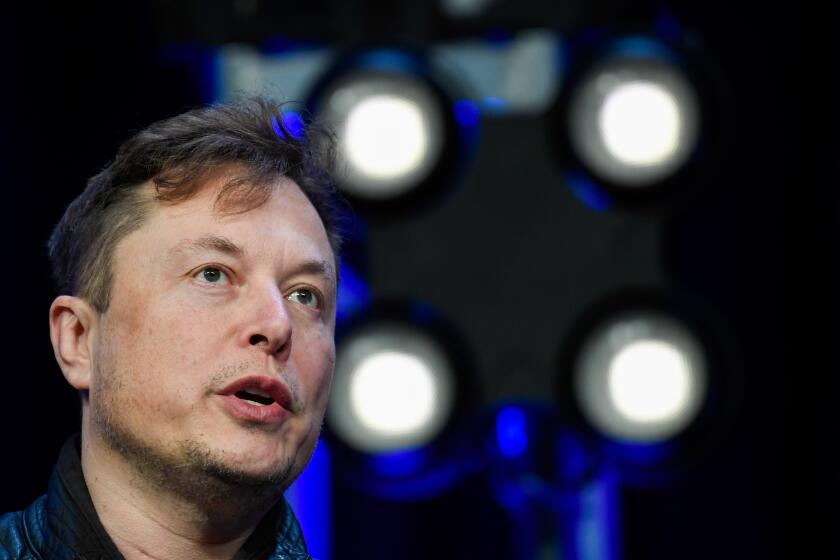Blueprint for ‘Car 2.0’
- Share via
WASHINGTON — Shai Agassi, once a senior executive at software giant SAP, has become a proselytizer for cars that run only on electricity. He isn’t selling cars, though; he’s selling a business plan.
Agassi wants private investors and governments to work together to build recharging stations at parking spaces and rig them so that motorists can be billed online. Fully charged cars could go 40 miles or so; for longer trips, motorists could pull into stations resembling carwashes and exchange their batteries for fresh ones.
As founder and chief executive of Palo Alto-based Better Place, Agassi has raised $200 million and reached agreements with San Francisco Bay Area cities, Hawaii, Israel, Denmark and Australia to establish supportive policies and infrastructure. Renault-Nissan will provide electric cars in Israel as early as 2010.
This month Agassi discussed the plight of the Big Three Detroit automakers and his hopes for his company.
--
How did you end up in the car business?
I was asked to deliver a presentation at the World Economic Forum on “how to make the world a better place by 2020.” That was in 2005. My project was to figure out a framework for how to convert an entire country from oil by the market, not by edict and not as a science project.
I put forward an idea for governments. Then [Israeli President] Shimon Peres said, “If you believe it but don’t do it yourself, why would anybody else jump on it?”
--
What do you think of the Detroit automakers’ new business plans and their appeal for federal assistance?
They’ve got a car that’s running on only two wheels, and they’re going to throw away some of the baggage.
We’ve had 100 years of “Car 1.0.” Thirty years after the Model T, we had Pearl Harbor. We’ve seen the value of a functioning car industry. A month after Pearl Harbor, we converted [the industry] into the lifeline of the world. A third of a century later, during the oil crisis, the industry had to change. But we squandered the opportunity. We let the Japanese carmakers come into the U.S. and do whatever they wanted. The oil shock came [and went], and we went on building tanks known as SUVs and Hummers.
The significance of the 1941 shock was that we converted to building tanks instead of cars and sent them to the soldiers. The symbolism of the second shock is that we actually sent tanks to the consumers. We squandered the opportunity to redesign this industry to disconnect from oil.
--
What would your plan for all-electric vehicles mean for the countries that adopt it and for the U.S. auto industry?
The United States cannot afford not to have a car industry. If it goes away, the economy is going to tank at speeds we haven’t seen before. . . .
But you have to have a fundamental change in the business model of cars. You’ve got an industry designed almost entirely on a product that doesn’t make money when it sells but only makes money when it comes back for service or resale. So they made money on financing the car. All that you needed was one pull on the oil price lever to destroy that model. Suddenly you’ve got cars that nobody wants to buy coming back to the lot. You took the leveraging risk into your business model. So fundamentally, the business model collapsed. You’ve got production overcapacity and multiple brands you don’t need.
It is almost like a falling knife. No one wants to catch it before it hits the ground. You know you have two choices. Do you extend the time before it hits the ground? Or do you design “Car 2.0”? I think it’s time to design Car 2.0 and use the American workers we have.
--
You’ve talked about making the purchase of automobiles more like buying cellphones. If motorists subscribe to your recharging service at a certain rate, you will give them cars free or at a deep discount.
What you need is cross-dependence. Think of razors and blades. The car industry is selling razors and everyone else is selling blades. Or it’s like Hewlett-Packard selling printers cheap and making money off the cartridges. What the auto companies need is to be in the blades business.
So what you need is a model where you’re getting some revenue from the miles driven. If Ford got 1 cent per mile for every Ford car on the road, Ford would get $10 billion a year straight to the bottom line. That’s more than the assistance check they’re asking for now.
--
Aren’t you relying on a lot of government support?
What we’re trying to say is that we don’t need government assistance. It’s the government that needs assistance. The government cannot afford not to go off oil. Every time the price of oil goes up, the trade deficit goes north of $1 trillion. Every time the economy starts picking up, it will crash because the price of oil will go up again. So the only way to get the economy picking up is to get off oil.
--
President-elect Barack Obama has called for a $7,000-per-car tax credit for plug-in vehicles. Does that raise your hopes for his support?
You cannot put electric cars on the road without the infrastructure, just as you can’t drive cars without gas stations. President-elect Obama has to say that every parking spot in America [needs] to have electric power. . . .
There’s no conduit to put [electricity] into cars. We’re still [eating off a] menu with one item, and it comes through gas stations fed through pipes and trucks. Until we change that, we’re stuck with the biggest monopoly on Earth: 12 countries [of OPEC].
That’s our moonshot: not to find another planet but to save the one we’ve got. This is the battle for the next century.
--
Mufson writes for the Washington Post.






